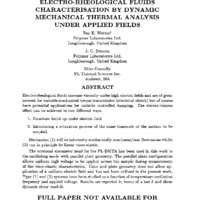-
Title
-
Electro-Rheological Fluids Characterisation by Dynamic Mechanical Thermal Analysis Under Applied Fields
-
Description
-
Electro-rheological fluids increase viscosity under high electric fields and are of great interest for variable mechanical torque transmission (electrical clutch) but of course have potential applications for variable controlled damping. The electro-viscous effect can be achieved in two different ways:Structure build-up under electric field
Introducing a relaxation process of the same timescale of the motion to be coupled.
Mechanism (1) will be inherently mechanically non-linear/non Newtonian whilst (2) can in principle be linear visco-elastic. The torsional rheometer head for the PL-DMTA has been used in this work in the oscillating mode with parallel plate geometry. The parallel plate configuration allows uniform high voltage to be applied across the sample during measurement of the visco-elastic characteristics. Cone and plate geometry does not allow application of a uniform electric field and has not been utilised in the present work. Type (1) and (2) systems have been studied as a function of temperature oscillation frequency and applied voltage. Results are reported in terms of a tan 8 and shear dynamic shear moduli.
-
Abstract
-
Electro-rheological fluids increase viscosity under high electric fields and are of great interest for variable mechanical torque transmission (electrical clutch) but of course have potential applications for variable controlled damping. The electro-viscous effect can be achieved in two different ways:Structure build-up under electric field
Introducing a relaxation process of the same timescale of the motion to be coupled.
Mechanism (1) will be inherently mechanically non-linear/non Newtonian whilst (2) can in principle be linear visco-elastic. The torsional rheometer head for the PL-DMTA has been used in this work in the oscillating mode with parallel plate geometry. The parallel plate configuration allows uniform high voltage to be applied across the sample during measurement of the visco-elastic characteristics. Cone and plate geometry does not allow application of a uniform electric field and has not been utilised in the present work. Type (1) and (2) systems have been studied as a function of temperature oscillation frequency and applied voltage. Results are reported in terms of a tan 8 and shear dynamic shear moduli.
-
Creator
-
Wetton, Ray E.
-
Duncan, J. C.
-
Connolly, Mike
-
Publisher
-
Wright-Patterson Air Force Base, OH : Wright Laboratory, Flight Dynamics Directorate, Air Force Systems Command
-
Date
-
1991
-
Format
-
1 online resource (1 page)
-
Type
-
article
-
Date Issued
-
1991-08
-
Extent
-
1
-
Corporate Author
-
Polymer Laboratories Ltd.
-
PL Thermal Sciences Inc.
-
Laboratory
-
Wright Laboratory
-
Report Number
-
WL-TR-91-3078 Volume II, page GAD-1
-
DoD Project
-
2401
-
DoD Task
-
240104
-
Distribution Conflict
-
No
-
Index Abstract
-
Contrails only
-
Photo Quality
-
Not Needed
-
Distribution Classification
-
1
-
Report Availability
-
Full text available
-
Provenance
-
University of Colorado Colorado Springs, Kraemer Family Library
-
Identifier
-
ADA241312
